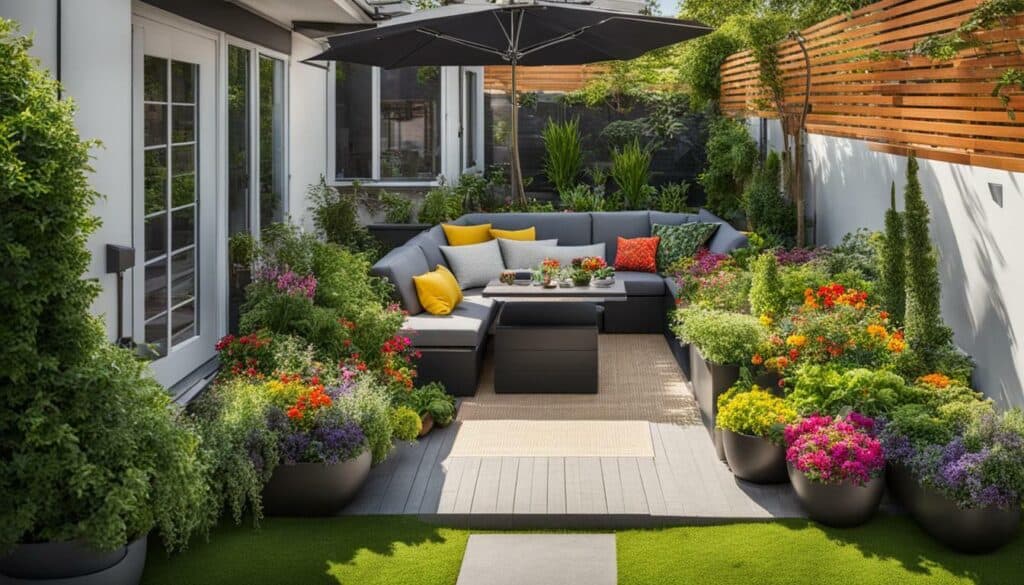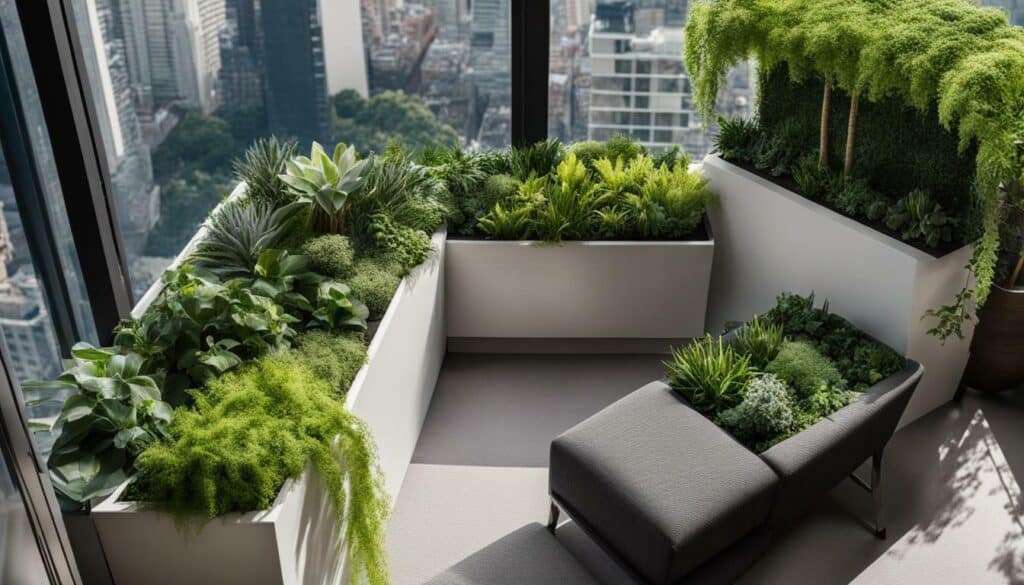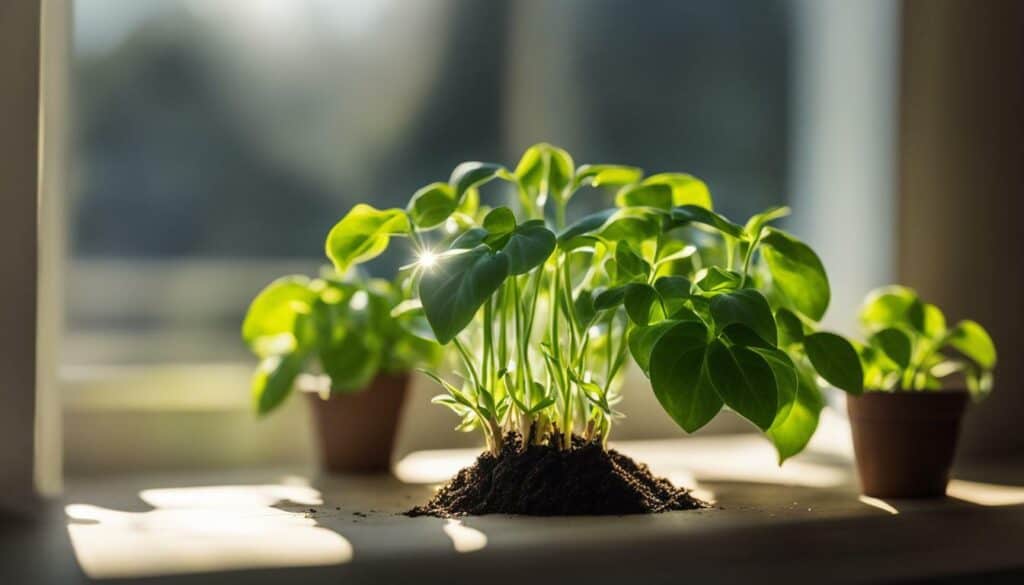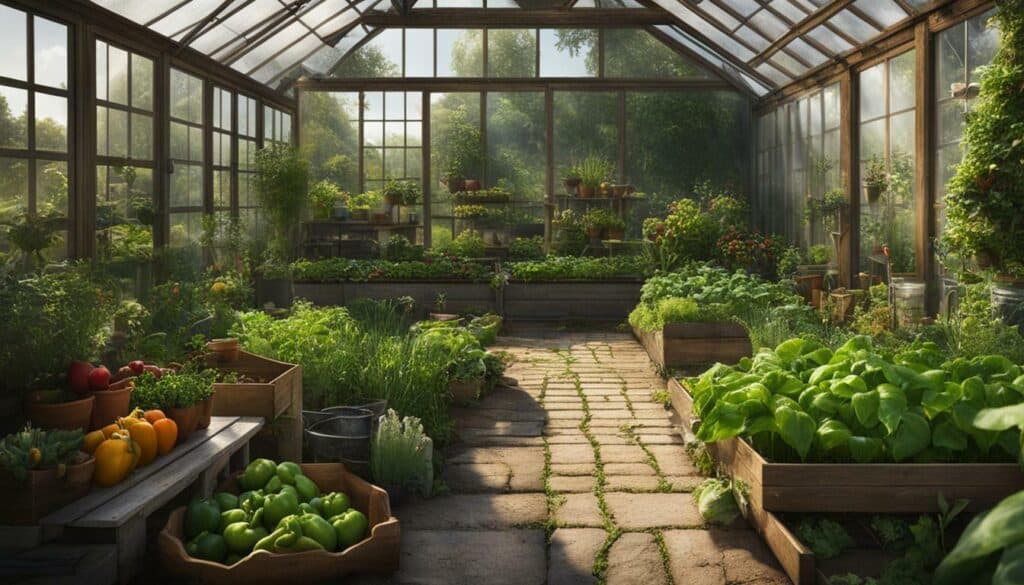Mastering your green thumb and becoming a skilled gardener is a skill that can be learned and developed over time with consistency, patience, and effort. Contrary to popular belief, having a natural talent for gardening isn’t necessary. Portable gardening is a popular option for those who frequently move or have limited space. It involves cultivating plants in containers such as pots or barrels, allowing for flexibility and ease of maintenance.
Choosing the right containers, selecting suitable plants, and providing proper care are essential for a successful portable garden. Consistent attention and adaptation to changes in climate or plant health are also important for maintaining a vibrant garden. It’s crucial to monitor plants for pests and diseases, provide regular watering and fertilization, and make any necessary adjustments to ensure their well-being.
Key Takeaways:
- Developing a green thumb is a learned skill that takes consistency, patience, and effort.
- Portable gardening is a popular option for those with limited space or who frequently relocate.
- Choosing the right containers, plants, and providing proper care are essential for a successful portable garden.
- Consistent attention and adaptation to changes in climate or plant health are necessary for a healthy garden.
Portable Gardens: Flexibility and Convenience for Gardeners on the Move
Portable gardens are a popular option for gardeners who need to relocate frequently, as they allow for flexibility and can be set up in containers such as pots, troughs, or barrels. This method of gardening provides a convenient solution for those with limited space, and offers the ability to rearrange the layout as desired.
As a gardener on the move, maintaining a portable garden requires attention and adaptation to changes in climate and plant well-being. However, the benefits of a portable garden include minimal disease and pest issues, suitability for limited spaces, and easy maintenance.
Considerations for Gardeners
When setting up a portable garden, it is essential to select the right containers and plants. The containers should be large enough to accommodate the root system of the chosen plants and sturdy enough to withstand movement. Plants that thrive in containers include herbs, flowers, and small vegetables such as lettuce, cherry tomatoes, and peppers. Choose plants that suit the climate and lighting conditions of the desired location.
Using high-quality potting soil is also crucial for a successful portable garden. It should provide the necessary nutrients and drainage for the plants, and be appropriate for the chosen containers.
Maintaining a Portable Garden
To preserve a portable garden, consistent attention and care are necessary. This includes regular watering, fertilizing, and pruning as required. Be mindful of changes in temperature, lighting, and humidity, and adjust plant care practices accordingly.
Overall, portable gardens offer a sense of continuity and the opportunity to enjoy gardening no matter where one moves. Whether for aesthetic purposes or fresh food production, a portable garden can provide both convenience and enjoyment.
Setting Up a Portable Garden: Tips for Success
When setting up a portable garden, it is important to choose the right containers, select plants that thrive in containers, use high-quality potting soil, and maintain regular care including watering, pruning, fertilizing, and pest control.
The first step in setting up a portable garden is to choose the right containers. Look for containers that are lightweight, durable, and have good drainage. Plastic, ceramic, and terracotta pots are popular choices, but you can also use hanging baskets, window boxes, or grow bags. Consider the size of the containers in relation to the plants you want to grow and the space you have available.
Next, select plants that are suitable for container gardening. Choose plants that have shallow root systems and fit comfortably in the containers you have selected. Popular container plants include herbs, vegetables, and flowering plants like petunias and marigolds. When selecting plants, consider the climate in your area and the amount of sunlight the container will receive.
Use high-quality potting soil to ensure that your plants have the nutrients they need to thrive. Look for potting soil that is lightweight, has good drainage, and is formulated for container gardening. Avoid using garden soil, which can become compacted and create drainage problems in containers.
Regular care is essential for the success of a portable garden. This includes watering your plants regularly, pruning them to maintain their shape and size, fertilizing them to promote growth, and monitoring them for pests and diseases. Be sure to adjust your care practices as needed based on the changing needs of your plants and the environment they are in.
With the right selection of plants and containers, a portable garden can provide joy and tranquility regardless of frequent moves. Remember that successful maintenance requires consistent attention and adaptability to changes, such as adjusting plant choices and care practices. Take the time to set up your portable garden properly, and you will be rewarded with a beautiful and thriving garden that can move with you wherever you go.

Benefits of Portable Gardens: Ideal for Limited Spaces and Aesthetic Flexibility
Portable gardens are ideal for limited spaces, providing ease of maintenance, and the ability to rearrange for aesthetic purposes. These gardens involve cultivating plants in containers rather than traditional in-ground beds, allowing for easy relocation and rearrangement. They are suitable for those with small yards or living in apartments. With the right selection of plants and containers, portable gardens can bring endless joy and tranquility, proving that gardening knows no boundaries.
One of the major advantages of a portable garden is the flexibility it offers. With a variety of containers available, you can create a garden that perfectly fits your space and aesthetic preferences. Whether you want to create a vertical garden on a balcony or add some greenery to a small patio, portable gardens can be customized to suit your needs.
Another benefit of portable gardens is that they face fewer issues with soil-borne diseases and pests. This is because you start with fresh potting soil each time you replant your containers, reducing the risk of contamination. Additionally, with the smaller scale of portable gardens, tasks such as weeding and pest control are more manageable.
Overall, portable gardens provide a convenient and versatile way to enjoy the beauty and benefits of gardening regardless of your living situation. With their easy maintenance and endless possibilities for customization, they are the perfect solution for anyone looking to add some greenery to their space.

Lessons from Movable Gardens: Patience, Observation, and Adaptability
Consistent attention and adaptation to changes are necessary for maintaining a vibrant movable garden. Tending to plants in containers requires extra care and vigilance, as they are more vulnerable to environmental changes and may require adjusting care practices to keep them healthy.
Lessons from movable gardens go beyond plant care – they teach us patience, observation, and adaptability. Patience is vital when waiting for plants to grow and thrive, especially when results are not immediate. Observation is necessary to detect changes in plant color, texture, or growth, which can indicate potential problems. Adaptability means being open to adjusting plant choices or care practices when necessary to maintain optimal health and growth.
One of the greatest benefits of movable gardens is their flexibility. They offer a solution for frequent movers or those with limited space. Portable gardens can be rearranged as desired and take up less space than traditional gardens. The use of containers also reduces the risk of disease and pests, making them easier to maintain.
| Challenges | Solutions |
|---|---|
| Changes in climate | Select hardy plants and adjust care practices as necessary. |
| Plant well-being | Monitor plant health and adjust care practices accordingly. |
| Limited space | Choose compact, space-saving plants and containers. |
To set up a portable garden, selecting the right containers is crucial. They should be large enough to accommodate the plant’s root system and have proper drainage. Suitable plants should be chosen based on the available space and sunlight exposure. Potting soil quality is also essential for plant health and should be replenished yearly.
Developing a successful movable garden takes time and consistent attention. Regular watering, fertilization, and pruning are essential for keeping the plants healthy and vibrant. With the right selection of plants and regular maintenance, movable gardens can provide endless joy and tranquility.
Developing a Green Thumb: Embracing a Growth Mindset
By embracing challenges and adapting to climate or care practices, valuable lessons in patience, observation, and adaptability can be learned. As a novice gardener, it is essential to understand that gardening is a skill that requires consistent effort and the willingness to learn. Contrary to popular belief, having a green thumb is not a natural talent, but a skill that can be developed over time with a growth mindset.
A growth mindset involves being open to learning, persisting through challenges, and viewing failure as an opportunity to learn and improve. It is essential to approach gardening with a growth mindset, recognizing that every success and failure is an opportunity to learn and grow as a gardener.
While some individuals may have a natural inclination towards gardening, anyone can develop the same level of skill and knowledge with the right resources and a growth mindset. There are numerous educational resources available, such as books, courses, and workshops, that can help individuals develop the necessary skills.
As a beginner gardener, it is essential to be patient and not expect immediate success. With consistent effort, patience, and a willingness to learn, anyone can develop a green thumb and enjoy the benefits of planting and agriculture.

Embracing a growth mindset is the key to developing a green thumb. By recognizing that gardening is a skill that can be learned and improved over time, novice gardeners can approach their plants with a sense of curiosity and wonder. With patience and persistence, gardeners can learn to care for their plants and develop a deep connection with nature.
Gardening Education: Resources for Knowledge and Skill Development
Anyone can develop a green thumb by approaching gardening with a growth mindset and a willingness to learn. Gardening education is key to acquiring the necessary knowledge and skills for a successful garden. Fortunately, there are many resources available to assist individuals in developing their gardening skills and knowledge.
Books
Books are a valuable resource for learning about different gardening techniques, plant care, and design. They can be purchased online or at a local bookstore. Some popular gardening books include “The Vegetable Gardener’s Bible” by Edward C. Smith, “The Flower Gardener’s Bible” by Lewis Hill, and “The Well-Tempered Garden” by Christopher Lloyd.
Courses and Workshops
Courses and workshops provide hands-on learning opportunities with experienced gardeners and farmers. Local community gardens, colleges, and botanical gardens often offer courses on topics such as composting, organic gardening, and plant propagation. Workshops on specific gardening skills, such as pruning or seed starting, are also available and can be found through online research or local gardening stores.
Online Resources
Online resources provide access to a wealth of information on gardening topics. Websites such as the National Gardening Association and American Horticultural Society offer extensive information on everything from plant care to landscape design. Online forums and social media groups offer opportunities for gardeners to connect and share knowledge and experiences.
Conclusion
Gardening education is essential for anyone interested in developing their gardening skills and knowledge. Books, courses, workshops, and online resources provide a wealth of information for individuals at all stages of gardening expertise. By investing time and effort into gardening education, individuals can achieve success in their gardens and enjoy the many benefits of gardening and agriculture.
Gardening for Sustainable Living: Self-Sufficiency and Fresh Food Production
Gardening offers numerous benefits for sustainable living. With a portable garden, individuals can cultivate their own fresh produce and reduce their reliance on store-bought fruits and vegetables. Creating a portable garden requires selecting suitable containers and plants that can thrive in them. It’s important to choose quality potting soil and provide regular maintenance, including watering and fertilizing.
The benefits of portable gardens extend beyond fresh produce. Portable gardens offer flexibility in rearranging the layout and can be easily moved, making them suitable for frequent movers. Portable gardens are also less susceptible to pests and diseases and can be ideal for limited spaces.
However, maintaining a portable garden requires consistent attention. Changes in climate and plant growth may require adjustments in care practices. With patience, observation, and adaptability, gardeners can learn to tend to the unique needs of their movable gardens.

Education resources such as books, courses, and workshops are available to help individuals develop the necessary skills and knowledge to become successful gardeners. By approaching gardening with a growth mindset and a willingness to learn, anyone can enhance their green thumb and cultivate a sustainable lifestyle.
Conclusion
Gardening and agriculture provide opportunities for sustainable living, self-sufficiency, and the production of fresh, home-grown food. It’s a common belief that gardening skills are innate, and some people just have a “green thumb”. However, this is a myth. Planting and caring for plants is a skill that can be learned with time and effort. With a consistent effort, patience, and a growth mindset, anyone can become a skilled gardener.
There are numerous educational resources available for those interested in learning more about planting and agriculture. Books, courses, and workshops are all great options for improving your gardening skills and expanding your knowledge. Additionally, tending to movable gardens teaches important skills like patience, observation, and adaptability in dealing with challenges and changes in climate or care practices.
Gardening and agriculture offer more than just a means of entertainment. They provide opportunities to live sustainably and self-sufficiently, as well as the joy of harvesting fresh, home-grown produce. With consistent effort, patience, and a growth mindset, anyone can develop a green thumb and enjoy the many benefits that come with it.
FAQ
Q: Can anyone develop a green thumb?
A: Yes, anyone can develop a green thumb by approaching gardening with a growth mindset and a willingness to learn.
Q: Are portable gardens suitable for gardeners who frequently relocate?
A: Yes, portable gardens are a great option for gardeners on the move as they allow for flexibility and can be set up in containers such as pots, troughs, or barrels.
Q: What factors should be considered when setting up a portable garden?
A: It is important to choose the right containers, select plants that thrive in containers, use high-quality potting soil, and maintain regular care including watering, pruning, fertilizing, and pest control.
Q: What are the benefits of portable gardens?
A: Portable gardens are ideal for limited spaces, provide ease of maintenance, and can be rearranged for aesthetic purposes.
Q: What can be learned from maintaining a movable garden?
A: Tending to movable gardens teaches valuable lessons in patience, observation, and adaptability in dealing with challenges and changes in climate or care practices.
Q: How can I develop a green thumb?
A: Embrace a growth mindset and a willingness to learn as you develop your gardening skills and knowledge.
Q: Are there resources available for gardening education?
A: Yes, there are various educational resources such as books, courses, and workshops to help individuals enhance their gardening skills and knowledge.
Q: What are the broader benefits of gardening and agriculture?
A: Gardening and agriculture provide opportunities for sustainable living, self-sufficiency, and the production of fresh, home-grown food.
What Are Some Simple Gardening Tips for Beginners?
Are you a novice gardener? Here are a few simple gardening tips and tricks to help you get started. Firstly, choose the right location for your garden, ensuring it gets ample sunlight. Secondly, start with easy-to-grow plants like herbs or vegetables. Thirdly, ensure proper watering by checking soil moisture regularly. Lastly, practice regular weeding and maintain the overall cleanliness of your garden.
Source Links
- https://www.trianglegardener.com/green-thumb-on-the-go-maintaining-a-portable-garden-for-frequent-movers/
- https://www.linkedin.com/pulse/gardening-agriculture-myth-green-thumb-power-learning-alvaro-nito
- https://www.linkedin.com/posts/rajatbhatiabusinessleader_salesgrowth-businessleadership-nurturingleads-activity-7094890660368908288-S_rH
- https://extension.wsu.edu/clallam/event/green-thumb-april-13/
- https://www.amazon.com/Mister-Owitas-Guide-Gardening-Unexpected/dp/0399157980
- https://www.amazon.com/Mister-Owitas-Guide-Gardening-Unexpected/dp/0425273830
- https://minnetonkaorchards.com/portable-greenhouse/
- https://www.epicgardening.com/accessible-garden/
- https://www.amazon.com/LEETOLLA-Elevated-Moveable-Vegetables-Backyard/dp/B0B6HMWL2Q
- https://www.gardensalive.com/product/first-time-veggie-gardenwhere-to-start
- https://www.gardeners.com/how-to/urban-gardening-with-vegetables/5491.html
- https://www.gardeners.com/how-to/raised-bed-tips-for-success/9554.html
- http://www.timberjay.com/stories/container-gardening-a-good-option-with-limited-space-e,20344
- https://themicrogardener.com/the-benefits-of-container-gardening/
- https://content.ces.ncsu.edu/extension-gardener-handbook/18-plants-grown-in-containers
- https://lisacarnochan.com/2019/09/9-lessons-life-amateur-gardener-saturday-morning-942am/
- https://www.yougrowgirl.com/what-makes-a-good-gardener/
- https://www.flipflopbarnyard.com/life-lessons-from-the-garden-patience/
- https://northernhomestead.com/successful-gardening-is-not-depending-on-a-green-thumb/
- https://www.doinggoodtogether.org/bhf/blog/little-green-thumbs
- https://njaes.rutgers.edu/fs1211/
- https://vtgardens.org/garden-organizer-toolkit/learning-in-the-garden/
- https://cns.ucdavis.edu/resources/garden-enanced-learning
- https://www.therusticelk.com/self-sufficient-garden/
- https://gardening.org/growing-a-garden-for-survival-plants/
- https://www.gardeningknowhow.com/edible/vegetables/vgen/self-sufficient-garden.htm
- https://chestofbooks.com/gardening-horticulture/Woman-Hardy-Garden/Chapter-XVI-Professional-Gardeners-Conclusion.html
- https://growingourown.wordpress.com/6-conclusion/
- https://www.ncbi.nlm.nih.gov/pmc/articles/PMC6334070/





Leave a Reply